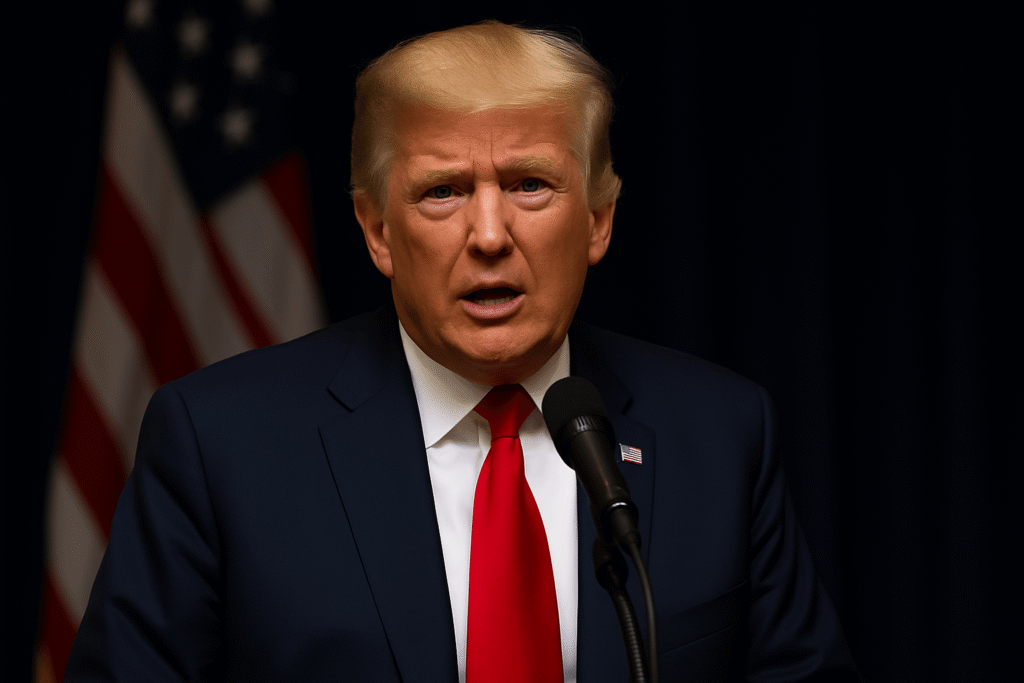In a landmark announcement shaking both Silicon Valley and Washington, President Donald Trump introduced a bold AI Action Plan designed to re-establish the United States as the global leader in artificial intelligence. The initiative pushes deregulation, empowers private-sector innovation, and seeks to strengthen America’s position in the growing tech war with China.
The AI Action Plan, dubbed the “America First AI Agenda,” marks a sharp policy pivot from the previous administration. With a focus on cutting red tape and fast-tracking critical infrastructure, Trump’s approach reflects a deeper vision: to secure U.S. AI leadership in a rapidly evolving digital arms race.
What’s Inside the AI Action Plan?

President Trump laid out five central pillars of the AI Action Plan, each aimed at rebuilding American dominance in AI research, development, and deployment. Here’s what the ambitious strategy includes:
1. Deregulation to Accelerate Innovation
Trump’s plan eliminates several bureaucratic hurdles that restricted AI research under prior administrations. The White House believes that loosening these rules will fuel breakthroughs in generative AI, defense technologies, and automation. This step, framed under the broader AI deregulation 2025 effort, reflects Trump’s belief that innovation thrives when government steps back.
“We’re unlocking American genius,” Trump said. “This AI Action Plan will unleash the full force of American innovation.”
2. Fast-Tracked Data Center Approvals
The federal government will now prioritize permitting for large-scale data centers, crucial for AI model training and cloud services. By speeding up infrastructure growth, the administration aims to support a long-term American AI strategy focused on domestic innovation and national resilience.
3. Federal AI Neutrality Standards
A controversial element of the AI Action Plan requires that only AI systems passing a neutrality test may qualify for federal contracts. These new AI neutrality standards aim to eliminate algorithmic bias in government-backed systems. While supporters see this as a safeguard against manipulation, critics warn it could limit freedom of expression in AI-generated content.
4. Public–Private AI Innovation Councils
Top executives and scientists from companies like Google, Meta, and OpenAI will lead AI advisory councils that shape national standards. These councils will also provide strategic guidance on model safety, ethical deployment, and international export competitiveness under the broader federal AI agenda.
5. Global Positioning and Counter-China Strategy
The U.S. will incentivize exports of American-built AI tools by streamlining export licenses and offering tax breaks. Trump directly linked this policy to resisting China’s rising dominance in AI, stating, “This is not just a race—it’s a battle. And we will win the tech war with China.”
Political and Industry Reactions Pour In
The Trump AI policy has sparked a fiery debate across party lines. Republican lawmakers have praised the announcement as a necessary evolution of U.S. tech policy, while Democrats question its potential risks. Senator Elizabeth Warren warned that deregulating AI could invite misuse and weaken public accountability.
Civil rights groups also voiced concern. The AI neutrality standards could limit transparency, they argue, particularly if neutrality is defined by political motives rather than scientific consensus.
Meanwhile, the tech industry has reacted with cautious optimism. In a joint statement, leaders from major AI firms commended the administration’s focus on infrastructure and global competitiveness. However, they called for clearer definitions around the neutrality clause and export guidelines.
“We support an AI ecosystem that promotes freedom, safety, and global leadership,” said an OpenAI spokesperson. “But clarity is critical.”
Why This Plan Matters for America’s Future
Artificial intelligence is no longer a futuristic concept—it is the core of global innovation. From national defense to education and economic growth, AI now powers the systems that shape society. The AI Action Plan aims to ensure these systems are built and led by the United States.
By linking national strategy to private-sector innovation, the administration is betting big on American ingenuity. If successful, this approach could drive job creation, bolster national security, and maintain the U.S.’s role as the global tech leader.
The White House has also promised transparent oversight of the AI Action Plan, with quarterly progress updates and open reporting from its innovation councils. Critics remain skeptical, but the administration insists that accountability and ambition can coexist.
